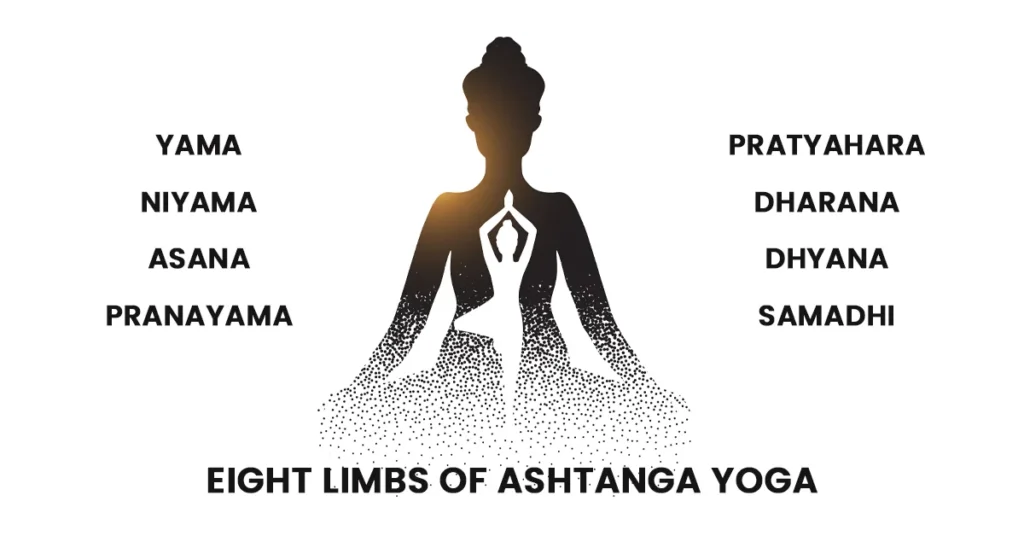Explore the world of Ashtanga Yoga for beginners! Learn what Ashtanga Yoga is all about, and discover how this ancient practice can transform your mind and body. Start your yoga journey today with our easy-to-follow guide.

Yoga is like a magical potion that people all over the world are drinking for better health and well-being. It’s not just one thing; It is a treasure trove of different forms and practices. Today, we are opening that trunk to discover a beautiful gem called “Ashtanga Yoga”.
Introduction to Ashtanga Yoga: What is the Ashtanga yoga?
Ashtanga Yoga is like a well-kept secret in the world of yoga. It’s an ancient practice with a powerful punch. “Ashtanga” means eight limbs, and this style is about aligning and synchronizing these eight limbs to create a harmonious and disciplined life.
Father of Ashtanga Yoga, Shri K. Pattabhi Jois created a specific sequence of postures and activities. They are like a roadmap, guiding you on a transformational journey. This practice is known for its empowering and dynamic nature, where you flow from one pose to the next with grace and control, coupled with deep focus on the breath.
So, why are we here today? We are here to guide you into the exciting world of Ashtanga Yoga. If you’re new to this exercise, don’t be afraid! We’ve got your help. Our aim is to help beginners like you embark on this journey with confidence and happiness. We’ll break down the basics, explain the postures, clarify Sanskrit terms, and provide tips to make your practice safe and enjoyable.
Ashtanga Yoga for Beginners
Are you ready to start an exciting adventure with Ashtanga Yoga, especially if you are new to it? Don’t worry if it seems a little difficult at first. With the right guidance, you will discover its amazing benefits and experience more happiness in your life through this practice. lets start!
Tips for Beginners
Now, let us look at some essential tips for starting Ashtanga Yoga as a beginner:
Find a qualified instructor: Look for a certified Ashtanga yoga instructor who can guide you through the practice safely and effectively. They can help you with proper alignment and adjustment.
Start slowly: Don’t rush the exercises. Start with the Primary Series, which is the foundation of Ashtanga Yoga. As a beginner, you can’t do all the asanas, and that’s absolutely okay.
Focus on breath: Breath is the essence of Ashtanga Yoga. Pay close attention to your breathing and try to synchronize it with your movements. This not only enhances the practice but also brings you into the present moment.
Practice regularly: Consistency is important in Ashtanga yoga. Try to establish a regular exercise schedule, even if it’s only a few times a week. Over time, you will notice improvements in your strength and flexibility.
Pay attention to your body: Always be kind to your body and don’t put too much pressure on it. If a yoga pose seems too difficult, you can change it slightly or leave it for now. As you keep practicing, you will naturally become more flexible and better at it.
Be patient and determined: Ashtanga Yoga is a journey, not a destination. It takes time to master asanas and experience their full benefits. Take your time and find joy in the journey.
Rest and Recover: Rest is very important. When you work out hard, your body needs time to recover and get stronger.
What are the Eight Steps or Eight Limbs of Ashtanga yoga?

The word “Ashtanga” comes from two Sanskrit words: “ashta” means eight, and “anga” means parts of your body. So, Ashtanga Yoga is about combining these eight aspects of Yoga to create a complete and perfect soul. Ashtanga Yoga, as outlined by the sage Patanjali in the Yoga Sutras, consists of eight stages or limbs, often referred to as the “eight limbs of yoga”. These steps provide a comprehensive guidance to live a balanced and harmonious life. They are here:
1. Yama: The first stage of Ashtanga Yoga, called Yama, focuses on the ethical and moral principles that govern our interaction with the world around us. There are five basic rules to follow. Non-violence promotes non-violence and kindness to all living beings and encourages kindness in life. Truth upholds truthfulness and honesty in our words and deeds, and it encourages the attainment of truth. Not stealing teaches us not to steal while respecting the property and boundaries of others. Brahmacharya emphasizes the right things, and guides us to use our energies wisely, not excessively. Dispassionate contentment encourages us to avoid greed and excessive attachment to material things, and encourages simplicity and contentment. These yamas act as moral guides to achieve a harmonious and sattvic lifestyle.
2. Niyama (personal observance): Niyama, the second stage of yoga, involves spiritual observance and self-control. This includes practices such as saying grace before a meal or taking a quiet nature walk alone. The rules include five principles: shaucha (purity), samosa (contentment), tapa (spiritual rigor), svadhya (self-study), and ishwapranidhana (surrender to God). This guide provides insight into connecting with our inner self, encouraging spiritual growth, and appreciating simplicity and personal growth.
3. Asana (physical postures): Asana refers to the practice of physical postures in yoga. It involves developing physical strength, flexibility and balance as well as calming the mind. Ashtanga yoga, as a physical practice, primarily emphasizes this body part.
4. Pranayama (breath control): Pranayama is like the breathing exercise in yoga. It helps us understand how our breath, thoughts and emotions are connected. By practicing pranayama we learn to control our breathing and emotions. In fact, the word “Pranayama” translates to “life force extension”, which means that according to yogis it makes us healthier and live longer.
ALSO READ: Intermittent fasting for weight loss: Unveiling the Secrets of Effective Intermittent Fasting
5. Pratyahara (Indriya Pratyahara): Pratyahara involves withdrawing the senses from external distractions and turning one’s attention inward. It is about gaining control over the senses to facilitate deep concentration.
6. Dharana (concentration): Dharana is the practice of focused concentration. It involves focusing your attention on a single point, object, or thought, which helps calm the mind and prepare it for meditation.
7. Dhyana (meditation): Dhyana is the state of meditation. It is a continuous, uninterrupted flow of awareness focused on a chosen object or point of concentration. In this state, the person meditating experiences a deep feeling of unity and oneness.
8. Samadhi (blissful union): Samadhi is the ultimate goal of yoga, where the practitioner experiences a profound state of blissful union with the divine or the universe. It represents the culmination of the yogic journey, where the practitioner transcends the ego and attains a state of spiritual realization.
These eight limbs of Ashtanga Yoga provide a holistic framework for self-development encompassing the physical, mental and spiritual aspects of life. While the physical practice of asana is a well-known aspect of Ashtanga yoga, it is important to remember that the ultimate goal is not just physical fitness, but a deeper understanding of oneself and a harmonious relationship with the universe.
What are the benefits of Ashtanga Yoga?
Ashtanga Yoga is like a superpower for your body and mind. Doing this regularly can make you feel better in many ways. Let’s look at some of the good things it can do for you:
Physical Fitness:
Improved Strength: The dynamic sequences of Ashtanga yoga build and tone muscles throughout your body, boosting overall physical strength.
Increased Flexibility: Regular exercise gradually increases flexibility in joints and muscles, reducing the risk of injury and increasing mobility.
Cardiovascular Health:
Improved Circulation: The vigorous nature of Ashtanga practice improves blood circulation, which may contribute to better heart health.
Weight Management:
Calorie Burn: Ashtanga yoga can be an effective form of exercise for burning calories and maintaining a healthy weight.
Stress Reduction:
Mental Peace: Synchronized breathing and mindfulness in Ashtanga yoga help reduce stress and anxiety, promoting mental peace.
Reduction in Cortisol: Regular exercise can reduce levels of the stress hormone cortisol.
Improved Posture:
Awareness: Ashtanga yoga emphasizes alignment and body awareness, which can improve posture in everyday life.
Detoxification:
Sweat: The dynamic nature of Ashtanga practice produces heat and sweat, which helps remove toxins from the body.
Mental clarity:
Concentration: Focusing on breath and movement in Ashtanga yoga increases concentration and mental clarity.
Emotional balance: Regular exercise can help regulate mood and emotional balance.
Spiritual growth:
Deeper Awareness: Ashtanga Yoga encourages self-reflection and self-discovery, leading to a deeper understanding of oneself.
Connection: Some practitioners believe that Ashtanga yoga promotes a sense of spiritual connection or oneness with the universe.
Better Sleep:
Relaxation: Relaxation techniques in Ashtanga yoga can improve sleep quality and help with insomnia.
Pain management:
Chronic Pain Reduction: Some individuals with chronic pain conditions report relief and improved pain management through regular Ashtanga practice.
Discipline and routine:
Self-Discipline: Consistent practice promotes self-discipline and can lead to positive changes in other areas of life.
Community and Support:
Sense of Community: Ashtanga yoga often fosters a sense of belonging and support among practitioners who share a similar practice.
It is important to note that the benefits of Ashtanga yoga can vary from person to person, and they often depend on factors such as frequency and consistency of practice. Whether you are looking for physical fitness, stress relief, or spiritual growth, Ashtanga Yoga can be a valuable tool in your journey toward better well-being.
Conclusion
Ashtanga Yoga offers a holistic approach to physical and mental well-being by combining ethical principles, physical postures, breath control, and meditation. For beginners, it offers a structured path to a healthier and more balanced life. By adopting the eight limbs, one can experience the transformative power of Ashtanga Yoga.
Frequently Asked Questions (FAQs)
What is Ashtanga yoga known for?
Ashtanga yoga is famous for its dynamic, physically demanding sequences of asanas, synchronized with controlled breathing. It is known to promote strength, flexibility and mental clarity. The practice emphasizes a systematic approach to discipline, alignment, and self-improvement through its eight-limbed path, making it a holistic and transformative yoga style.
Is Ashtanga the hardest yoga?
Ashtanga yoga can be a little difficult because it has difficult postures and a set sequence. But remember, what is hard for one person may not be for another. It depends on how fit you are and what you want to achieve. If you keep trying and going step by step, Ashtanga can become easy and can help you a lot.
Can Ashtanga yoga build muscle?
Yes, Ashtanga Yoga can help in building muscles. It involves holding challenging poses that engage different muscle groups, promoting strength and endurance. Over time, consistent practice can improve muscle tone and definition. However, it may not provide the same muscle-building results as weight lifting or resistance training.
How Ashtanga yoga change the body?
Ashtanga yoga can do a lot of good things for your body. It makes you more flexible, gives you stronger muscles and helps you stand straight. Doing this often can improve your heart health, reduce stress, and clear your mind. Additionally, it makes you sweat, which helps in getting rid of the wastes in your body. It also makes you feel balanced and happy.
why Ashtanga yoga is the best?
Ashtanga Yoga makes your body move along with your breath. It’s really important to focus on your breathing in this yoga. It’s like a moving meditation that helps calm your mind, reduce stress, and change the habits you want to improve.
Can Ashtanga yoga help lose weight?
Yes, Ashtanga Yoga can aid in weight loss. It combines physical postures, controlled breathing and a challenging exercise that burns calories and builds lean muscle. Regular exercise, along with a balanced diet and lifestyle, can contribute to gradual and lasting weight loss.
“Good news! Te Mend is now available on WhatsApp & Telegram Channels. Subscribe today through the link and stay updated with the latest news!” Whatsapp & Telegram




